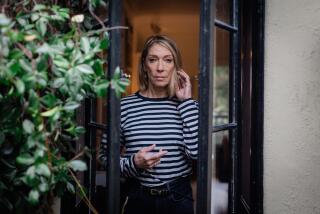Patti Smith’s memoir of a rock-poet
Nostalgia is never more suspect than when the person romantically harking back is too young to have experienced the era firsthand. But reading Patti Smith’s memoir “Just Kids,” a tender recollection of her coming of age as a singer-songwriter alongside her artistic soul mate, the late photographer Robert Mapplethorpe, I couldn’t help envying the cultural ferment of the late ‘60s, early ‘70s and wondering how we could recapture some of the dirty magic.
The generation that followed was my lucky lot. No swinging ‘60s or hippie ‘70s for me. The Reagan-Bush years — marked by trickle-down economics, two epidemics ( AIDS and crack cocaine) and crime rates that make the threat of terrorism today look like a summer holiday — provided the inhospitable background to my creative loafing. Bob Dylan and his ilk took a backseat to the last days of disco and the neon flare of New Wave. “Dynasty” and “Dallas” rode the crest of the Nielsen wave, Andrew Lloyd Webber established a beachhead on Broadway, and wanting to be an artist meant staying in university. I ducked into the Yale School of Drama for several years and came out, of all blasted things, a critic.
Today, my peers, armed with advanced degrees in the arts, run MFA programs, help guide philanthropic foundations, and a dwindling few even serve as cultural arbiters at newspapers and magazines. Before moving to L.A., I was on the faculty of Brooklyn College’s MFA program in theater. If I were still there, I’d make “Just Kids” required reading.
Smith’s story serves as an antidote to the trend of the last few decades in which artists have become arguably more proficient in the technical aspects of their disciplines through formalized training but often at the expense of a natural connection to a thriving cultural community.
We’ve established enclaves to protect young artists from an American economy so ruthless that the ivory tower has become a primary locale for creative development and mentorship. Where else can artists think and experiment, practice and fail, without being seen as malingerers? But there’s a price to be paid for this separation from the workaday world. (Consider the plight of contemporary playwrights fresh out of top-flight universities and searching frantically for arable soil for their theatrical endeavors.) The portrait Smith paints of New York in the promiscuously freewheeling age of Warhol documents what has been lost along the way since Ivan Boesky and his Wall Street accomplices made greed an article of national faith and a sanitized professionalism came to dominate the cultural landscape.
There’s a refreshing lack of careerism in Smith’s account of her days before fame graced her journey. Would she be a poet, actor, visual artist, rock critic, part-time jewelry maker or simply Mapplethorpe’s muse and occasional model? The answer isn’t clear until well into the book when she’s traveling with a band, and even then she makes eluding pigeon-holes a priority. The artistic journey genuinely seems to be the destination. One of her greatest achievements was her sui generis 1975 debut album, “Horses,” but what seems to mean the most to her about this breakthrough is the intriguingly mannish photo Mapplethorpe took of her for the cover.
Apprenticeships are tough, and Smith was often stressed out about money, the emergencies of her friends and fatalities of her starry acquaintances. Housing in New York was considerably cheaper back then, but an unknown artist lacking a trust fund has never had an easy ride, and rent and food money were urgent questions mark for her.
“I was always hungry,” she confesses. One particularly famished moment, when she didn’t have enough coins at the automat, Beat poet Allen Ginsberg, mistaking her for “a very pretty boy,” treated her to a much-needed sandwich.
Her teachers were her friends, lovers and fellow urban travelers. And her graduate school was the Hotel Chelsea, the raffish refuge of bleary-eyed poets and half-mad artists that she moved into with Mapplethorpe in 1969.
“The Chelsea was like a doll’s house in the Twilight Zone, with a hundred rooms, each a small universe,” Smith writes. The shabby elegance turned her on. And the building’s surreal memories, roaming like ghosts down the hallways, invited her to find her place within a bohemian tradition that included Dylan Thomas scribbling before his last bender, Bob Dylan working on “Sad-Eyed Lady of the Lowlands” and Warhol muse Edie Sedgwick, who was rumored to have set her room on fire while “gluing on her thick false eyelashes by candlelight.”
Smith worked in bookstores while Mapplethorpe — her lover for a time, her roommate for longer, and her aesthetic partner in crime until he died from AIDS-related causes in 1989 — concentrated on his visual art projects, stumbling into photography in the same trial-and-error way that Smith eventually found her métier in rock poetry. He exhorted her to keep drawing, worried that she might be too provocative (a delectable irony from an artist who found his posterity in the forbidden) and escorted her to Max’s Kansas City, where Warhol’s Factory crowd haughtily held court.
Smith’s growth occurs through her relationships. Mapplethorpe was a central pillar, but others, including Todd Rundgren and Sam Shepard, also played crucial roles. She acted in plays off-off-Broadway, even though this type of performance took her out of her comfort zone. She offered poetry readings in front of crowds who were impatient for the main musical act. These experiences, no picnic for her, widened her palette of influences.
“I don’t even know what I’m doing,” she confided to Mapplethorpe after he picked up some of her poems tossed in frustration on the floor. “I’m like a blind sculptor hacking away.” Yet she persevered in her blindness, finding her bearings instinctively and deriving momentum from the example of others.
Score-settling isn’t her MO in this memoir. When reflecting on lovers who didn’t always do right by her, she acknowledges the wound while not short-changing the love. Smith is clearly looking back in tranquility, but she’s also staying true to the communal ethos that shaped her.
Of the crash-and-burn luminaries that weren’t always so welcoming to her at Max’s Kansas City, she has only sympathy for their tragic ends. “I feel no sense of vindication as one of the handful of survivors,” she writes. “I would rather have seen them all succeed, catch the brass ring. As it turned out, it was I who got one of the best horses.”
It’s not possible, of course, for young artists to conjure into existence the milieu from which Smith and Mapplethorpe emerged. The world has become at once more global and more virtual. Local isn’t as easy to come by anymore, as the coast-to-coast domination of chain stores makes clear. Hand-held technology encapsulates urban-dwellers in pods of their own. And the Hotel Chelsea is now a boutique hotel eager to lure expense-account travelers looking for a little edge.
But I detect a renewed idealism in the newer generation. The MFA students I’ve taught in recent years, the young artists I come across in my theatergoing, seem to be less self-enclosed, more attuned to progressive political and social change. The crises they face — economic and environmental, chief among them — won’t allow them to fret all day over their résumés. The planet beckons them with alarm bells. Advice from the generation that more or less trashed their future should be treated skeptically. But if they read “Just Kids,” they might just learn that friendship can lead to radical new ways of seeing.
charles.mcnulty@latimes.com
More to Read
The biggest entertainment stories
Get our big stories about Hollywood, film, television, music, arts, culture and more right in your inbox as soon as they publish.
You may occasionally receive promotional content from the Los Angeles Times.







